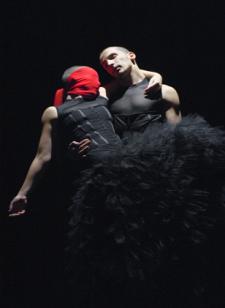 |
Mercy photo Michael Rayner |
The whole work, in its choreography, music and design is markedly formal. The brief passages of Pergolesi’s Marian Vespers determine the duration of each scene and evoke, of course, a religious formalism matched in the choreography by gestural imagery of supplication, benediction, crucifixion and pieta-like cradlings. Even their opposites—images of torment and torture—share a Baroque neatness, a dancerliness at times courtly and with evidence too of the balletic underpinnings of much modern dance. It’s when this formalism is broken or a series of images suddenly coalesce into something more potent that Mercy makes its mark in the memory.
A man, stretched out on the floor, wrestles with his chains but what disturbs is a sudden and repeated sharp stiffening of the whole body at the moment he puts his hands behind his back as if to have them bound. One victim struggles desperately in a swathe of red ribbon delicately wrapped about him by his tormentors. Another victim uses her body to plead with her gaoler, wrapping herself around him, climbing and clinging to him, losing grip to fall from his temporary or denied grasp. He catches her exhausted body one more time and she falls, totally and frighteningly limp, face down across his extended arms. He leaves her body behind. Is the gesture he makes one of perverted benediction? Another powerful image is of inert bodies carried in a slow dance across the stage, as if in rigor mortis.
Amanatidis and Dunn stand out in a somewhat uneven ensemble. Daniel Zika's powerful lighting creates spaces both epic and claustrophobic. Greg Clarke’s costumes include identical bodices and striking skirts for male and female dancers (and the principals share short-cropped hair) creating ambiguity and dark elegance—creatures transcending gender and too beautiful to be destroyed. Unfortunately the balance of the costuming—bare-buttocked, leather strapped—looks the cliched stuff of S&M fantasy, reinforcing a feeling that the content of the work is at the mercy of a sleek aesthetic that undercuts the immediacy of its concerns—fortunately not always.
In a final series of images, Derek Amanatidis dances a remarkable solo of supplication, arms reaching high in a convincing embodiment of prayer, circling low
and returning again and again to stretch up for grace. Amanatidis and Trish Dunn whose bodies have hitherto remained apart but are drawn to one another now entwine in movements of subtle caring such as the gentle cradling of a head. The two separate and lie passively on the stage as a row of torturers advances slowly on them. There is no mercy here, perhaps only in the care they have shared and a dream of grace for those who believe in God’s beneficence—a distant prospect here for all the beauty of the music and the empathy of the choreography. Mercy is at its best when its images of suffering, supplication and caring are at their strongest, when the extremities of torment and yearning are palpable in the dancers’ bodies.
Tasdance, Mercy: a dance for the forgotten, choreography & conceptual design Raewyn Hill, dancers Floeur Alder, Trisha Dunn, Derrick Amanatidis, Malcolm McMillam, James Shannon, Tanya Voges, costume & set design Greg Clarke, lighting design Daniel Zika; Theatre Royal, Hobart, Ten Days on the Island, March 22-24
Keith Gallasch is the Managing Editor of RealTime.
© Keith Gallasch; for permission to reproduce apply to [email protected]








 back
back